Pagliacci 101. Part 2
By Kelly Maxwell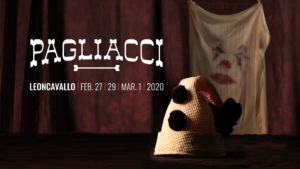
If you ask anyone to hum a melody from an opera, even if they have never seen an opera, they are very likely to hum the iconic line from Pagliacci. The soaring tenor line of “Vesti la giubba” has totally infiltrated our collective consciousness, saturating our most popular songs, films, and television shows. The sad clown archetype has, for better or worse, pushed its way into both our comedies and our dramas. Clowns may have started off the second half of the 20th century as a technicolor Bozo, but that genuine grin was quickly replaced by tears and terror. I’m joined again by Music Historian Betsy Schwarm, the adept scholar behind Opera Colorado’s pre-performance lectures, who is armed with additional insight into this quintessential opera.
In the second installment of our Opera 101 Series, we’ll take a deep-dive into all things Pagliacci. So wash off that greasepaint and brace yourself for an in-depth examination of verismo opera, Commedia dell’arte, and (gulp) clowns. If you’re at all spooked or squeamish at the sight of a red nose, refer back to the synopsis and character study, which is refreshingly devoid of any murder clowns. BUT! If you’re equipped with curiosity and a sturdy disposition, read on!
Can you think of another pop-culture reference? Comment below and let us know what your favorite Pagliacci moment is. We’ll add it to the playlist too!
PAGLIACCI’S ORIGIN TALE
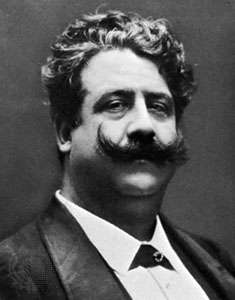
Ruggero Leoncavallo wrote both the score and the libretto for Pagliacci (Italian for the clowns). He was tremendously inspired by the success of Mascagni’s 1890 verismo opera, Cavalleria Rusticana. Although he wrote more operas after Pagliacci, including a La bohème in 1897 that was overshadowed by Puccini’s 1896 work by the same name, he is remembered almost exclusively for his first work. Pagliacci premiered at the Teatro dal Verme in Milan on May 21, 1892 and was conducted by a 25-year-old Arturo Toscanini. According to the most widely accepted version of events, Leoncavallo was inspired by a real-life case of *domestic violence and an on-stage murder, presided over by his magistrate father. The French author Catulle Mendès accused Leoncavallo of plagiarizing his 1874 play La Femme de Tabarin because his play also featured a play-within-a-play and an on-stage murder. Mendès ultimately dropped the lawsuit after he himself was accused of plagiarism for a different play.
Commedia dell’arte
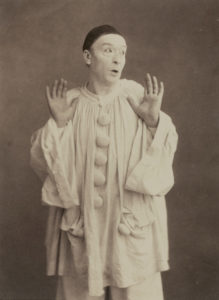
The great Commedia dell’arte tradition inspired the play undertaken by the performers in Pagliacci. The iconic characters that come from the performance tradition would have been immediately comprehensible to the audiences of the day. They would have instantly recognized the sad clown Pierrot (Pagliacco), the perky maid Columbina (Nedda), or the Harlequin servant Arlecchino (Beppe). Relying on these archetypes, the theatrical conventions would have instantly made the performance accessible and familiar to the common folk. Commedia dell’arte performances were often improvised or loosely scripted on familiar scenarios. Canio abandoning his character in Act II takes the audience a little while to figure out because they don’t have a script to refer to. Every performance was different from the last, making their final performance even more disturbing. The audience was on-board with the entire ordeal until it was too late for Nedda and Silvio.
Verismo Opera
Because he was so inspired by Mascagni’s Cavalleria rusticana, Leoncavallo hopped aboard the verismo train. Verismo (Italian for “realism”) was an Italian post-Romantic tradition, most often associated with the Italian composers Leoncavallo, Mascagni, and Puccini. Like naturalism, a popular literary movement of the same era, verismo works in opera sought to characterize the world with heightened realism. These works focused on the “real world” drama of the common folk, departing from prior grandiose operatic works based on fanciful characters, gods, or grand nobility. Cavalleria rusticana is Italian for “rustic chivalry” and it didn’t feature palace intrigue or royal antics. Leoncavallo took this as his cue to write an analogous real-life drama, set in a similar small Italian village.
PAGLIACCI IN POP CULTURE
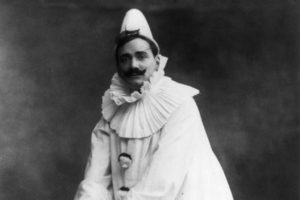
The iconic aria “Vesti la giubba,” sung by Pagliacco, immediately following his realization that his wife Nedda has humiliated him by her affair with Silvio. His heart breaks as he has to prepare to take to the stage as a clown. The juxtaposition of his tremendous pain and plastering on a fake smile makes this aria one of the most iconic in all of opera. In fact, the first record to sell one-million copies was famed tenor Enrico Caruso’s 1902 recording of “Vesti la giubba” from Leoncavallo’s Pagliacci. So, of course, his soaring tenor lines have been repurposed to be a stand-in for any and all operatic moments. The tune has been used to sell everything from Coca Cola to Rice Krispies. It has also appeared to heighten emotional climaxes of many films and television shows, most notably The Simpsons, Seinfeld, and The Untouchables. The character Pagliacci has transcended genres and became a stand-in for any type of heartbroken or murderous clown.
Check out the Youtube playlist below to watch some of the most iconic moments featuring “Vesti la giubba” and painted clown faces.
The Pagliacci Playlist:
Many popular tunes have used playing Pagliacci as a metaphor for hiding heartbreak behind a smile. Perhaps most notably Smokey Robinson’s “Tears of a Clown” and Nancy Wilson’s “The masquerade is over” feature references to playing Pagliacci. Many other artists have quoted the iconic lines from the opera, including Queen and Maynard Ferguson. Frank Sinatra also used an image of himself painted as a harlequin clown on the cover of his 1958 album, Frank Sinatra Sings for Only the Lonely. Check out the Spotify playlist below to listen to our favorite Pagliacci-related tracks.
THE FUNNY CLOWN
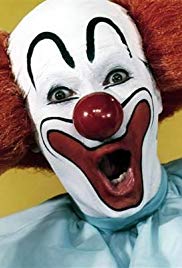
This trope is probably the most familiar and accessible, so let’s keep things light and fun… While we can… The circus clown we know today, complete with the white face, red nose, and mischievous slapstick antics, took over pop-culture in post World War Two America. Bozo the Clown and The Bozo Show influenced television, marketing, and toys in the 1960’s and beyond. Think of Bozo as an pre-Act I Canio. Bozo was so popular that McDonalds modeled their mascot, Ronald McDonald, after the character in order to capitalize on the clown craze. Although he somewhat straddles the line between funny clown and sad clown, Krusty the Clown has been one of the most popular characters on The Simpsons. His behind-the-scenes persona, an alcoholic chain-smoking depressive, leads us straight to the melancholy clown.
THE SAD CLOWN
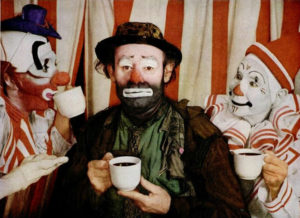
When I think about the sad clown trope, I don’t imagine a painted performer with the blues, rather, I think of every stand-up comedian whose life was tragically cut short by their pain. Robin Williams, Lenny Bruce, and Chris Farley were all funny men who hid their tragic dark side. Just like Canio, their pain eventually overtook them and forced them out of the spotlight, to their demise. Schwarm remembers the old joke, “A man goes to doctor. He says he’s depressed. He says life seems harsh and cruel. He says he feels all alone in a threatening world. The doctor says, ‘Treatment is simple. The great clown, Pagliacci, is in town tonight. Go and see him. That should pick you up.’ The man bursts into tears. He says, ‘But doctor, I am Pagliacci.’” This joke was perfectly illustrated in Alan Moore’s 1986-87 DC series Watchmen. The comics were so popular, they were eventually turned into a 2009 film and a 2019 HBO series.
Is Canio really that different than Robin Williams or Lenny Bruce? Schwarm notes, “Canio’s turmoil is so familiar that the story has come to life as the (above) recurring joke. One could muse upon the enduring concept of funny men who hide their tears; surely the composer Leoncavallo did not invent the idea. However, when the title of an opera becomes so familiar as to serve as the punchline of a piece of humor, that opera – and especially its most famous, most heart-wrenching aria – are part of public consciousness.”
- Pierrot Origins in the seventeenth century and later as a stock character in Commedia dell’arte (see above)
- Emmett Kelly as Weary Willie An American circus performer. “Weary Willie” was based on Depression era hobos
- Alan Moore’s Watchmen (see above)
THE SCARY CLOWN
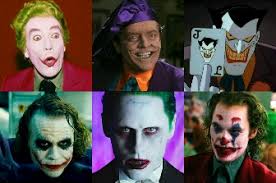
I feel bad for even bringing this one up… But you know that Pagliacci has had a HUGE impact on our nightmares. It is, after all, spectacular nightmare fuel. The enduring legacy of the tortured clown with an axe to grind has inspired countless pop-culture villains. The Joker from the Batman comics and films is a perfect example of the enduring legacy of the scary clown. Actors have clambored after the role because it is the perfect mixture of righteous vigilante, tragic clown, and psychotic nut-case. The scary clown has, unfortunately, influenced our waking nightmares when the trope takes a turn for the worse and ends up in real-world headlines. John Wayne Gacy’s chilling character, Pogo the Clown, only magnifies the horrors he inflicted in 1970’s Illinois. More recently, real world clowns infiltrated our nightmares when videos of Wrinkles the Clown went viral in in 2015. A documentary was released in 2019, attempting to uncover the truth about the creepy clown-for-hire in Naples, Florida. Take a deep dive (if you dare!) into the Complete History of Scary Clowns via Vulture:
- The Joker First appearance in Batman #1 (April 25, 1940)
- Crazy Joe Davola Seinfeld Season 4, Episode 9 “The Opera” (1992)
- Pennywise It (1990), It (2017), It Chapter Two (2019)
- Captain Spaulding House of 1000 Corpses (2003)
- Twisty the Clown American Horror Story: Freak Show Season 4, Episode 1 “Monsters Among Us” (2014)
- Pogo The Clown aka John Wayne Gacy
- Wrinkles the Clown Anonymous performance art/cultural phenomenon (2015-)
“When I need the idea, I can find it immediately. I have a horror of rewriting or deleting; the parts of my composition are carried in my head ’till I can write them down, even to the last note. Then I do not alter a jot.” Ruggero Leoncavallo
*SafeHouse Denver is an excellent local resource for women and children living with domestic violence. Their 24-Hour Crisis & Information Line can be reached at 303-318-9989.
Kelly Maxwell is Opera Colorado’s Multimedia Producer.
Opera Colorado’s production of Leoncavallo’s Pagliacci opens Thursday, February 27. Tickets and more information can be found here.
